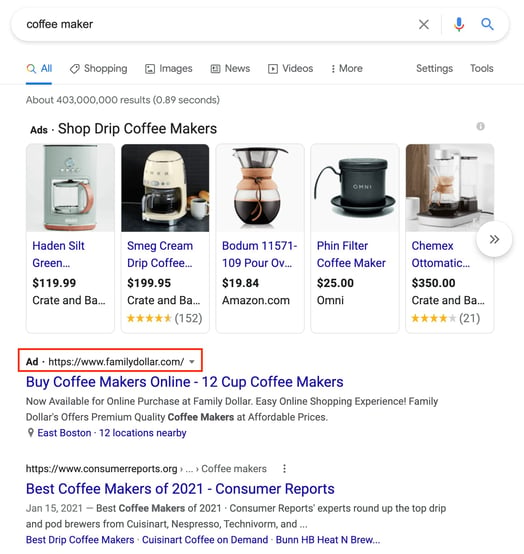Search engine optimization (SEO) and search engine marketing (SEM) can be confusing concepts to grasp. The terms are often used interchangeably, making it difficult to understand the differences between the two.
However, as marketers, it is essential to understand the difference, as they both mean separate things. In this post, we’ll define SEM, explain how it’s done, and outline how it’s different from SEO.
![→ Download Now: SEO Starter Pack [Free Kit]](https://no-cache.hubspot.com/cta/default/53/1d7211ac-7b1b-4405-b940-54b8acedb26e.png)
What is SEM?
Search engine marketing (SEM) is the process of using paid advertising to give your site higher rankings in search engine result pages (SERPs) and increased visibility. An SEM practice that you may already be familiar with is pay-per-click (PPC) advertising.
For SEM to be effective, you need an SEO strategy. You can think of it like this: your SEO strategy will let you know which keywords you need to include in your SEM ads to ensure that you’re relating to queries your target audience is already interested in.
What is the benefit of SEM?
SEM is essential because it ensures that your target audience sees the content you create in their search query results. You’re not left competing for organic space, as your advertisements are shown at the top of the first SERP page. You can effectively reach your target audience, drive traffic, and boost conversions.
Is paid search the same as SEM?
At this point, you may be wondering, “If I can pay for my website to appear higher in search results, how is seM different from paid search?” While paid search is a significant pillar of SEM, specifically pay-per-click (PPC) ads, the two strategies are different.
The key distinction is that SEM is a broad strategy that can include paid search and SEO tactics. If you set up a PPC ad but don’t take steps to optimize it, or the website it links to, that is a standard PPC ad. However, if you optimize your ad content with relevant keywords from your SEO strategy and spend money to display it in SERPs, you’re using SEM to create effective PPC ads.
What components does SEM include?
As mentioned above, SEM includes SEO best practices, as well as paid search tools like PPC.
In addition, some SEM strategies include optimizing for local search results, so your business, products, or services are shown in search queries for people browsing for nearby solutions.
What Is Search Engine Optimization (SEO)?
SEO is the process of increasing your business’ visibility and rankings in organic search results. Higher rankings can result in more traffic, increased conversions, and high ROI.
SEO best practices are constantly changing as Google makes changes to its algorithm, but, at its core, SEO is made up of a few standard techniques, which we’ll cover below.
What components does SEO include?
As stated above, SEO is comprised of multiple different activities:
- Incorporating selective keywords naturally into title tags, heading tags, meta descriptions, and alt text.
- Blog posts and page copy that is high-quality and includes business-relevant keywords.
- Carefully formatted page URLs
- Optimized page load speed
All-in-all, SEO best practices are aligned with three core components: on-page, off-page, and technical SEO.
What components does off-page SEO include?
As the name suggests, off-page SEO includes anything that happens, well, off of your website. This can involve obtaining backlinks from high-quality and authoritative sites, social sharing, and social bookmarking.
SEO vs. SEM
The main difference between SEO and SEM is that the former uses organic strategies to appear in SERPs, while the latter uses paid tactics. Although they often work hand-in-hand, it’s important not to use the terms interchangeably, as they don’t mean the same thing.
It may be helpful to have an example, which is displayed below. The image is a search query for a coffee maker.

The first result, outlined in red, is an example of SEM.
Family Dollar used paid ads to execute their search engine marketing campaign, and their page is the first result. The result immediately below it is there due to an organic SEO strategy for the same query.
Many marketers debate whether one is better than the other. It ultimately depends on your business needs, but effective SEM can’t exist without using your organic SEO strategy.
Additionally, there are situations where PPC can be more impactful than SEO. For example, if you are launching a new site and want immediate visibility, it will be easier to get your feet off the ground with a paid ad because it takes less time for your site to be visible in SERPs.
However, it would be detrimental to your business to solely rely on SEM, as an organic strategy can still bring beneficial results. You can also learn about your target audience and iterate and improve upon your strategy based on analytics.
When choosing the best tactic, it is crucial to evaluate your specific needs, but be sure to fully understand the differences and how you will maintain your efforts. Check out Revenue River's free guide for how SEO how-to.
Editor's Note: This blog post was originally posted in January 2014, but was updated in April 2021 for comprehensiveness.

